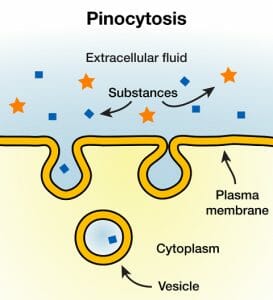Pinocytosis Definition
Pinocytosis is the method by which a cell absorbs small particles outside the cell and brings them inside. The word pinocytosis comes from the Greek for “cell drinking”. During this process, the cell surrounds particles and then “pinches off” part of its membrane to enclose the particles within vesicles, which are small spheres of the membrane. This process is usually used for taking in extracellular fluid (ECF).
Function of Pinocytosis
Pinocytosis is a type of endocytosis. Endocytosis is when a cell takes in particles by engulfing them with its membrane. The other types of endocytosis are phagocytosis (“cell eating”), which is nearly the same as pinocytosis but involves the cell takes in a greater amount of particles, and receptor-mediated endocytosis, which is when particles are taken into a cell by binding to receptors.
Small particles of substances in the ECF are absorbed into the cell via pinocytosis. It is a process that requires active transport, which means that it requires energy on the part of the cell (as opposed to a process like simple diffusion). It is non-specific; although it is triggered by the presence of certain substances outside the cell such as amino acids or certain ions, it results in the absorption of many different substances by the cell at the same time, such as water and various solutes like sugars and proteins.
This figure depicts pinocytosis:

Steps of Pinocytosis
- An inducer substance, such as a protein, binds to a receptor on the cell membrane. Note that this is different from receptor-mediated endocytosis because multiple types of molecules will be taken in by pinocytosis instead of just one specific type.
- The cell membrane forms a small open-ended pocket, or invagination, around the part of the ECF that is going to be absorbed into the cell.
- The cell membrane starts to reconnect at the open end of the invagination, or “pinch off”.
- When the cell membrane has fully pinched off the invagination, a vesicle is formed. This is a small sphere of the cell membrane that surrounds the materials that the cell has just taken in. It prevents the molecules from disrupting the rest of the cell as they are transported.
- The molecules inside the vesicle are eventually released to be used by other parts of the cell.
Examples of Pinocytosis
Pinocytosis is widely used among the cells of the body, but there are specific situations where pinocytosis plays a major role. Microvilli in the gut use this process to absorb nutrients from food. Cells in the kidney can use pinocytosis to separate nutrients and fluids from the urine that will be expelled from the body. In addition, human egg cells also use it to absorb nutrients prior to being fertilized.
Types of Pinocytosis
Pinocytosis is broken down into macropinocytosis or micropinocytosis based on the size of the vesicle that is formed. Vesicles formed from macropinocytosis are about 1-2 µm in length (0.0001-0.0002 cm), while those formed from micropinocytosis are even smaller, about 0.1 µm, and are formed from the tiniest indentations in the cell membrane.
Differences between Pinocytosis and Phagocytosis
Pinocytosis and phagocytosis are similar processes, but they have some key differences. Phagocytosis is used to absorb materials much bigger than the particles that can be absorbed by pinocytosis, such as bacteria. Phagocytosis involves the ingestion of solid materials, while pinocytosis involves the ingestion of liquids and solute particles. During pinocytosis, the contents of the vesicles are emptied directly into the cell, but this doesn’t happen in phagocytosis because the contents of the vesicles are too big. Lysosomes must combine with the vesicles to break down the contents. This process does not occur in pinocytosis.
Related Biology Terms
- Endocytosis – When a cell takes in particles through invagination of the cell membrane.
- Phagocytosis – Also known as “cell eating”; when a cell absorbs large particles such as whole bacteria.
- Invagination – The process by which a structure (in this case, the cell membrane) is folded back or turned inside out to form a pocket or cavity.
- Vesicle – A small sphere of membrane inside the cell that can uptake and transport materials such as nutrients or waste products.
Quiz
1. Which is NOT a step of pinocytosis?
A. An inducer molecule binds to a receptor on the cell membrane.
B. An invagination forms, surrounding part of the ECF.
C. The particles are brought into the cell via a vesicle.
D. Lysosomes digest the contents of the vesicle.
2. What is NOT a type of endocytosis?
A. Receptor-mediated
B. Pinocytosis
C. Cytosine
D. Phagocytosis
3. Which of these would not be absorbed by pinocytosis?
A. Proteins
B. Bacteria
C. Sugars
D. Water
